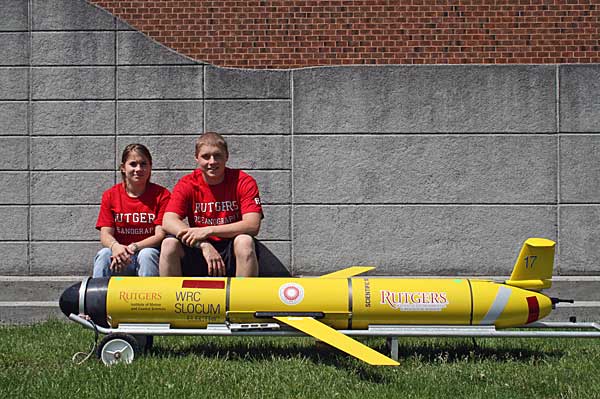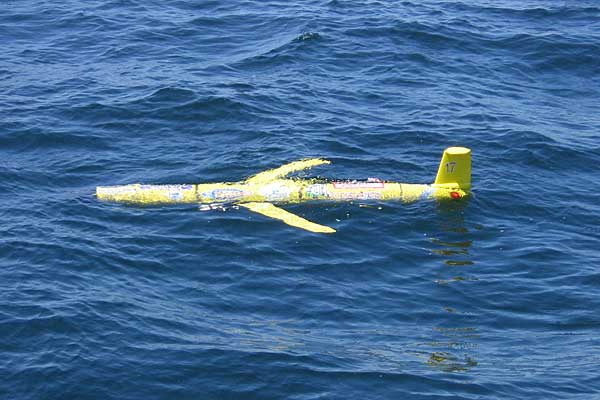About This Mission
The Challenge
Several years ago, Rutgers University professors Scott Glenn, Oscar Schofield and Josh Kohut attended a workshop in Europe. They were there as part of an effort to foster international oceanographic collaborations between developing European nationals and the United States. Also in attendance was Dr. Richard Spinrad, the Assistant Administrator of the National Oceanic and Atmospheric Administration (NOAA). One evening, he pulled Drs. Glenn, Schofield and Kohut aside to challenge them with what he described as a mission of national importance.
At the time, scientists at Rutgers University had pioneered the use of underwater Slocum Gliders to autonomously sample the ocean. Engineers at Rutgers had successfully deployed gliders several dozen times in places all over the world, including in the Sargasso and Mediterranean Seas and off the coasts of Florida, Hawaii and New Jersey. Glider missions often lasted over a month and covered distances of 500 km or more. But Dr. Spinrad had a grander challenge.
"For the good of your country, you need to fly a glider across the Atlantic."
It is often said that public interest and literacy has fallen in recent years. In order for the U.S. to stay competitive in the emerging global marketplace, it is essential that today's students remain motivated and learn the essential skills that will help them compete with their peers across the globe. The launch of Sputnik energized an entire generation of scientists, engineers and teachers. We need a new Sputnik to excite the youth of today and energize a new generation of students in the science and technology fields.
For this reason, Dr. Spinrad told us we needed to bring everyone along with us.
When you go on an adventurous mission, if you succeed, everyone will have wanted to follow along with you. And if by chance you happen to fail, those who follow along will understand more fully the challenge at hand.
Science is not about the pretty result at the end, rather, it's about the arduous process researchers often have to take to get there. Our task is to help the public understand the true nature of science, and the best way to do that is to let them follow on a voyage of adventure.
Crossing the Atlantic with an autonomous robot would be Oceanography's new Sputnik. And the Internet will allow anyone and everyone to swim with the glider as it makes its way across.
That's what this mission and this site are all about.
Attempt #1
For those of you new to following along with us, we previously attempted to fly one of our gliders across the Atlantic. That glider, RU17, was unfortunately lost just off the coast of the Azores. However, while the glider failed to complete its intended flight across the Atlantic, the mission itself was groundbreaking. We learned an immense amount of information about many different aspects of the mission. Information ranging from glider flight dynamics and characteristics to physical and biological impediments to the dire importance for collaborative international relationships. We will take everything we learned from our first attempt with RU17 and combine it with our knowledge from rigorous testing of our new transatlantic glider, RU27, as our entire Glider Team works together to fly RU27 across the Atlantic Ocean.
The Plan
"As the crow flies," the straight-line distance between Tuckerton, New Jersey (our projected launch point) and Cape Touriñán, Galicia (the westernmost point of Spain – our projected landing point) is 5,323 kilometers (or 3,308 miles). On its own power in still waters, the glider flies about 0.5 knots (about 0.58 miles per hour). At that speed it would take the glider around 240 days to cross the Atlantic.
But, like the atmosphere, the ocean is a fluid and has currents that constantly move and shift. These currents can majorly affect the glider’s flight. For instance, if the glider happens to wander into an area where the current flows against the direction the glider is headed, the glider will loose ground. On the other hand, if the glider finds itself in an area of the ocean moving in the same direction, it will gain speed. As it turns out, there is a major oceanic current in the mid-latitudes that regularly flows eastward towards Europe. This welcomed current is called the Gulf Stream.

The warm waters of the Gulf Stream form in the Caribbean Sea and then flow into the Gulf of Mexico before rounding the southern tip of Florida. The water then flows north-northeast along the coasts of Georgia and the Carolinas. After passing the coast of Cape Hatteras, the Gulf Stream heads eastward. At speeds of 2-3 knots, the Gulf Stream will greatly reduce the time it will take to fly across the Atlantic if we can manage to keep the glider in the middle of the stream and out of any Gulf Stream meanders or rings. Unfortunately, the Gulf Stream only flows to about 50° West, at which point it breaks apart into a series of small eddies and slower currents called the North Atlantic Drift.
We intend to fly RU27 into the Gulf Stream and afterwards carefully and deliberately navigate through the eddies of the North Atlantic Drift and use their eastward motions to propel the glider towards Europe, just like the European explorers of the past used this same current to return home.
The trick will be deftly navigating the current fields using satellite and model data to take advantage of any currents heading eastward, while avoiding those heading westward. We only have a limited amount of battery power available, so student pilots at Rutgers are helping to ensure the glider is steered through the most efficient course possible.








